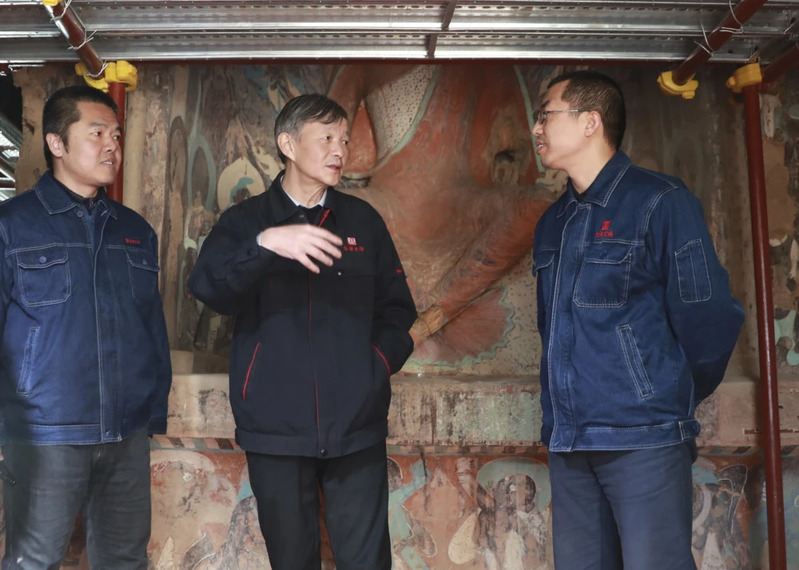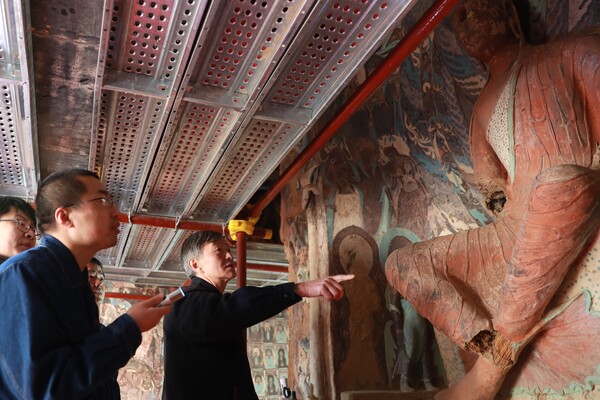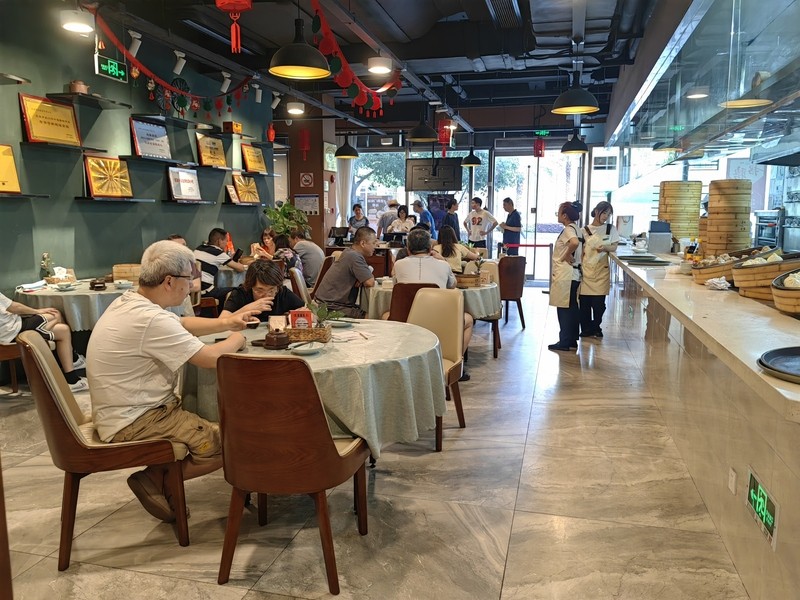Su Bomin, Dean of Dunhuang Research Institute: How difficult is it to protect Dunhuang murals? Dunhuang | Protecting | murals
Dunhuang murals are often old and sickly, and the pigment layer will gradually rise and become soft, falling off when the wind blows... How difficult is it to protect Dunhuang murals? Please listen to Su Bomin, the director of the Dunhuang Research Institute, recounting the difficult process of restoring and protecting Dunhuang murals on Gansu TV's "Silk Road Lecture Hall" program. The following is the main content of the speech.
Su Burin and Dunhuang Research Institute of technical personnel in the discussion of cultural relics restoration.
I came to Dunhuang Research Institute in 1992. Prior to that, I worked in chemical analysis, majoring in chemistry.
Many people ask me: As a chemistry student, why do you come to work in Dunhuang, such an art temple? My answer at that time was: protecting and restoring Dunhuang murals requires the use of a lot of scientific and technological research and problem-solving, and I have a place to be useful in Dunhuang.
Until today, I am proud to say that I have transformed from a chemistry major with chemical thinking to a cultural relic worker dedicated to mural restoration and protection.
"The initial protection was mainly focused on simple maintenance."
Let me first introduce the difficult process of protecting Dunhuang murals.
There are 735 caves, 45000 square meters of murals and more than 2000 painted sculptures in the Mogao Grottoes of Dunhuang. It is the most dazzling "pearl" on the Silk Road and an outstanding representative of Chinese excellent traditional culture. However, for hundreds of years since the mid-16th century, the Mogao Grottoes have been left unattended and have suffered significant natural and man-made damage. It was not until the establishment of the Dunhuang Art Research Institute in 1944 that the protection, restoration, and research of the Mogao Grottoes began.
In 1944, the Mogao Grottoes were a very dilapidated scene: the cliffs on which the caves were built had multiple cracks, posing a risk of collapse; The boardwalk in front of the cave is severely damaged and presents a state of decay; The cave is open, with fragments of murals scattered on the ground, and many caves are even buried by quicksand.
The Mogao Caves are located in a special geographical environment, where the wind and sand are everywhere, surrounded by deserts and Gobi. Every spring, sandstorms flow down the cliffs of Mogao Grottoes, and a large amount of quicksand accumulates in front of the caves. Over time, the caves will be buried, causing erosion and damage to the murals.
At that time, the famous painter Mr. Chang Shuhong returned from France and brought a group of people to the Mogao Caves. When they saw the scene in front of them, they were very heartbroken because they were all artists. They saw that the Dunhuang murals, which had been dormant for thousands of years, were so brilliant and brilliant, and they were determined to protect this precious cultural heritage.
Mr. Chang Shuhong was the first dean of the Dunhuang Research Institute. In order to protect the cave, he led everyone to put down their brushes and books, pick up the shovel, push up the ox cart, and start cleaning up the sand in front of the cave. Subsequently, they carefully investigated one cave after another, numbered each cave, understood the current situation of each cave, and carried out classification and registration of the caves. During the day, they simplify their lives and are busy clearing up accumulated sand; At night, I would search for historical records and study the content of murals under an oil lamp. Their work at the Dunhuang Research Institute was spent day after day like this.
The excavation and construction history of Mogao Grottoes dates back over 1000 years. The reason why exquisite murals can be preserved to this day is because ancient painters used natural mineral pigments that can be preserved for a long time when painting. However, after years of erosion and sandstorms, Mr. Chang Shuhong's Dunhuang murals face many problems. For example, some murals are on the verge of large-scale detachment, which is one of the biggest dangers that murals face, because once they fall off, the murals disappear completely. Some murals also exhibit surface warping of the pigment layer, contamination by water stains and mud, and damage by insects or other microorganisms. Even the paint layer of some murals gradually becomes soft, and it will fall off when the wind blows. When they saw these problems, they were extremely anxious, so they thought of some ways to reinforce the paint layer of the mural, such as using mud to reinforce the edges of the mural that were about to fall off, hoping that the mural could be preserved for a longer time.
"The Mogao Caves have a 'mural doctor'"
In 1957, the protection of Dunhuang murals received high attention from the central government. The Ministry of Culture invited Mr. Joseph Glar, a cultural relic protection expert with over 30 years of experience in mural restoration in Czechoslovakia, to visit the Mogao Grottoes for inspection and lectures.
Joseph Glar introduced the methods and materials for repairing murals abroad, and conducted on-site experiments on repairing murals in Cave 474 of the Mogao Grottoes using the adhesive he brought. His method is to use a medical injection needle to inject the aqueous solution of the adhesive into the cracks of the nail wall painting, and then flatten it with gauze and cotton balls. This is the first time we have seen this method of mural restoration. It's like a doctor giving injections to a patient, so some people vividly refer to mural restoration workers as "mural doctors".
However, this Czech expert is unwilling to disclose the core technology to us, such as the specific components of the adhesive used for repairing murals. So, after the Czech experts left, we began to search and screen from existing materials. At that time, the Dunhuang Research Institute did not have experimental instruments and could only use high-temperature methods such as steaming and boiling to screen materials. Finally, an ideal repair material was found. In this way, combined with the method of injection repair, the Dunhuang Research Institute has developed the first generation of repair technology and techniques for mural nail removal in China.
In the following decades, we rescued thousands of square meters of murals on the brink of falling off through this method. However, after many years, we found that some repaired murals had problems again. What is the reason for this? We spent a lot of time but couldn't find the specific reason.
After the reform and opening up, the protection of cultural heritage in China began to receive global attention. In 1987, the Mogao Grottoes of Dunhuang were included in the first batch of World Cultural Heritage List in China because they met all six standards of world cultural heritage. At that time, the protection of Mogao Caves also received high attention from UNESCO. Through the matchmaking efforts of UNESCO, staff from the Getty Institute, the most famous cultural relic protection institution in the world at that time, came to Dunhuang and began collaborating with cultural relic protection workers from the Dunhuang Institute to study the restoration and protection of Mogao Grottoes murals.
"Pioneering repair technology for mural" cancer ""
The first phase of our collaboration with the Getty Conservation Institute mainly focuses on preventing and controlling sand damage, studying cave microenvironment, and so on.
We have not only introduced some Western cultural relic restoration technologies and methods, but also introduced Western cultural relic protection concepts. The first step of the Getty Conservation Institute's mural protection is to comprehensively understand and evaluate the historical, artistic, and scientific value of cave murals, which is the most fundamental work in cultural relic protection. The next step is to conduct a detailed investigation and record of the preservation status of the murals, and monitor their environment. They used a large amount of analytical equipment to carefully analyze the pigments, production techniques, and existing problems of the murals. After a period of time, our work results received widespread praise in the industry.
By 1997, we began conducting targeted research on diseases such as soda ash murals.

Suan alkali mural is one of the most serious, harmful, and difficult to treat diseases in Dunhuang grotto murals, known as mural "cancer". As I mentioned before, after a few years of repairing the murals, the problem of armor peeling has reappeared. What is the reason for this? We have chosen Dunhuang Cave 85 as an international cooperation project for protection and restoration. The staff installed temperature and humidity monitoring equipment in every corner and position of the cave to monitor changes in temperature and humidity inside the cave. At the same time, specialized instruments were used to study changes in the chemical composition of the alkali parts. After several years of research, we have finally identified the culprit behind the occurrence of alkali disease.
Originally, there was a layer of mud underneath the pigment layer of the mural, called a ground stick. In the basement layer, analysis revealed a large amount of soluble salts. As the name suggests, soluble salt refers to salts that are soluble in water, including the common salt we eat, sodium chloride, etc. These types of salts are highly susceptible to absorbing moisture from the environment. After absorbing moisture, soluble salts will deliquescence. When the air dries, it loses moisture and turns back into white crystalline particles. This repeated process of crystallization and deliquescence can cause the mural to become brittle and alkaline, causing the pigment layer of the mural to lose adhesion with the ground layer, peeling off armor, and even the entire ground layer to become loose soil and completely fall off.
What should we do next when we find the culprit of the disease? It's about separating salt from the ground layer of the mural. You can imagine that it is very difficult to separate salt from mud or soil, let alone facing such precious murals.
After several years of research and extensive experimentation, we have finally found a method to remove salt from murals, which we call grouting desalination technology. After 7 years of trying more than 80 formulas, the 85th cave in Dunhuang has finally been repaired, and the mural "cancer" has finally been eradicated.
It can be said that Cave 85 in Dunhuang can be regarded as a classic case of Chinese mural protection, and it has a milestone significance in the history of Chinese mural protection. Since the establishment of the People's Republic of China, the state has attached great importance to the protection of cultural relics, but at that time, there was still a lack of a comprehensive and comprehensive scientific understanding of cultural relics protection. The restoration of Cave 85 in Dunhuang not only enabled us to find technical methods for treating diseases caused by soluble salts, but also established a complete set of scientific procedures for mural protection, from investigating the current situation of murals and caves, evaluating the value of murals, monitoring the environment, analyzing materials, to establishing protection and restoration methods. This international cooperation also led to the promulgation of the Guidelines for the Protection of Chinese Cultural Relics and Monuments.
"How many tourists can Mogao Grottoes receive per day at most?"
With the vigorous development of the Chinese economy and the continuous improvement of people's living standards, more and more tourists are visiting the Mogao Grottoes. However, the Mogao Caves are also beginning to face a new problem. Every summer, in July, August, and September, there is a tourist peak in Mogao Grottoes, with tens of thousands of tourists flocking to the caves every day. A long time ago, our senior dean Fan Jinshi paid attention to this question: Will so many tourists entering the cave have an impact on the protection of the murals? How can we ensure the safety of cultural relics while satisfying tourists?
So, we started working with experts from the Getty Conservation Institute in the United States and the Australian Heritage Commission to study this issue. This research topic is called "Research on the Tourist Carrying Capacity of Mogao Grottoes", which aims to evaluate and analyze the maximum number of tourists that can be received in a day in the open caves of Mogao Grottoes.
Everyone knows that everyone's body has heat, and when tourists enter narrow caves, they will exhale a large amount of carbon dioxide. At the same time, the heat emitted by tourists can also cause changes in the microenvironment inside the caves. For example, the humidity and temperature inside the cave can change due to the influx of a large number of tourists, seriously affecting the microenvironment that murals rely on for long-term preservation and posing a threat to fragile murals.
After investigation and evaluation, we found that there are only 112 caves with an area of over 13 square meters, mild diseases, and suitable for opening in the Mogao Grottoes. And these 112 caves, with a maximum capacity of 2 people per square meter and a single cave visit time of 5 minutes, can minimize the risk of temperature and humidity changes on murals and provide visitors with the best visiting experience.
After calculation and research, we have finally come to the conclusion that the maximum daily tourist carrying capacity of Mogao Grottoes is 6000 people. But in fact, during the peak tourist season in summer, the daily number of visitors to Mogao Grottoes is 20000. For this reason, we have adopted a reservation system, and visitors are first allowed to watch the details of the murals in the digital exhibition hall before entering the cave to visit. We are doing everything possible to reduce the impact of tourists on the mural environment of the cave.
Now, we have set an upper limit on the changes in cave temperature and humidity caused by tourist visits. The humidity of the cave cannot exceed 62%, and the carbon dioxide content cannot exceed 1500 PPM. PPM is one millionth.
In today's Mogao Caves, we can see that real-time temperature and humidity monitoring devices are installed in all caves. Through the monitoring center, we can perceive real-time changes in the environment inside the cave, as well as minor changes in the mural pigment layer and the basement layer. By monitoring these changes, we can have a scientific understanding of the health status of murals and the preservation status of cultural relics.
The cultural relic protection concept of Dunhuang Research Institute is to protect and make reasonable use of cultural relics while providing tourists with a relaxed and comfortable tourism environment.
"Guarding Dunhuang murals will always be on the way"
There are often some misconceptions about the protection of cultural relics.
For example, in the caves of Mogao Grottoes, some murals have fallen off in large areas or even disappeared. Some tourists ask: can we repaint them completely? For example, if there are problems with certain parts of Dunhuang murals, can we use paint to patch them up? I can confidently tell everyone: No! Because there is a basic principle in cultural relic protection, which is to maintain the authenticity and integrity of cultural relics. That is to say, to maintain the original state and appearance of cultural relics.
The purpose of cultural relic protection is to truly and comprehensively preserve cultural relics and continue their historical information and full value. All protection measures must adhere to the principle of not changing the original state of cultural relics. So, we travel to many places and see some cultural relics being restored to new appearances. As industry insiders, we feel very regretful that this is actually a wrong form of protection.
Now, we can use digital technology and other means to restore murals in the virtual world. We can redraw murals in their entirety, but in reality and in caves, we should still maintain their true and complete original state.
The restoration and protection of Dunhuang murals have gone through a difficult process of over 70 years. Today, the Dunhuang Research Institute has a large number of cultural relics protection talents from multiple disciplines such as chemistry, geology, civil engineering, physics, biology, and environment, becoming the largest cultural relics protection team in the country.
Our current cultural relic protection work is oriented towards the future. In order to preserve the complete and intact Dunhuang murals to the next generation, we have proposed the concept of preventive protection. That is to study the small changes that occur in murals in the natural environment, and then use environmental control and other intervention measures to prevent or slow down these changes.
For over 30 years, the Dunhuang Research Institute has compared key parts of murals through photos every year. It is gratifying that the changes in murals are very small and almost imperceptible. I believe that with these new protection technologies and such a preservation environment, Mogao Grottoes will surely be able to survive for another millennium. One thing our generation has done throughout their lives is to preserve the Mogao Caves for a longer period of time, even longer.
Finally, I would like to say that World Cultural Heritage belongs to humanity and also to all of us. Protecting the precious millennium cultural heritage of our country is the responsibility of each and every one of us. Only by fully preserving China's excellent traditional culture can Chinese civilization become more brilliant and brilliant in the world, and be passed down for a longer and more enduring time.





